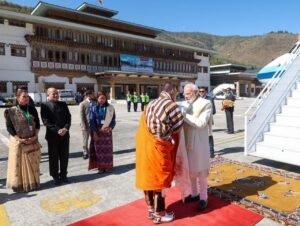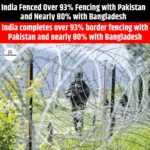PM Modi Begins Two-Day Visit to Bhutan
|
General Studies Paper II: India and its neighbourhood, Effect of policies and politics of countries affecting India’s interests |
Why in News?
Prime Minister Narendra Modi arrived in Bhutan on November 11, 2025, for a two-day state visit aimed at deepening the time-tested friendship between India and Bhutan. This visit will focus on expanding development partnerships and people-to-people connections.
Proposed Plans of Prime Minister’s 2025 State Visit to Bhutan
- During his visit, the Indian Prime Minister will hold important meetings with Majesty King Jigme Khesar Namgyel Wangchuck and Prime Minister Tshering Tobgay of Bhutan. Both sides are likely to discuss ongoing projects and explore new avenues in areas like digital connectivity, green energy, and tourism.
- Both the countries will jointly inaugurate the 1020 MW Punatsangchhu-II Hydroelectric Project, developed in partnership between the Government of India and the Royal Government of Bhutan, stands as a symbol of the nations’ cooperation in sustainable energy.
- Prime Minister Modi will also take part in the 70th birth anniversary celebrations of Majesty Jigme Singye Wangchuck, the Fourth King of Bhutan. His Majesty is widely respected for guiding Bhutan’s transition to a constitutional monarchy in 2008 and introducing the philosophy of Gross National Happiness (GNH).
- The visit coincides with the exposition of the Sacred Piprahwa Relics of Lord Buddha from India, which are being displayed in Bhutan for public veneration. Prime Minister Modi will offer prayers to the Holy Relics at Tashichhodzong in Thimphu.
- Prime Minister Modi will join the Global Peace Prayer Festival organized by the Royal Government of Bhutan. The event celebrates Bhutan’s commitment to peace, environmental balance, and cultural harmony—values that India strongly supports.
- This State Visit is expected to open new chapters in India–Bhutan cooperation. Both sides may announce fresh initiatives in education, technology, infrastructure, and green development. The hydropower sector, road infrastructure, and capacity-building projects are central to this partnership.
Background of India–Bhutan Relations
- The relationship between India and Bhutan is one of the most trusted and time-tested partnerships in South Asia.
- It is built on friendship, mutual respect, and deep cultural understanding.
- Since India’s independence in 1947, the two countries have maintained close cooperation based on shared values of peace, respect for sovereignty, and mutual growth.
- India was among the first nations to recognize Bhutan as a sovereign country after 1947, setting the foundation for a relationship rooted in trust and goodwill.
- The Treaty of Friendship and Cooperation, signed on August 8, 1949, is the cornerstone of India–Bhutan relations. The treaty established a framework of peace, non-interference, and mutual assistance. The treaty laid the basis for close political and economic cooperation.
- In 2007, the treaty was revised to reflect Bhutan’s evolving role as a modern democracy and India’s respect for its sovereignty. The India–Bhutan Friendship Treaty of 2007 reaffirmed the principles of cooperation but gave Bhutan full freedom in its foreign policy decisions.
- Both countries share common values of democracy, environmental responsibility, and peaceful coexistence. Bhutan’s philosophy of Gross National Happiness (GNH) aligns closely with India’s vision of inclusive and sustainable development.
- Cultural and spiritual ties have always been the heart of the India–Bhutan relationship. Buddhism connects the people of both nations through shared values of peace, compassion, and tolerance. Many Bhutanese monks and scholars study in Indian monasteries and universities.
- The partnership now extends to new sectors such as digital technology, space cooperation, education, climate action, and renewable energy.
Areas of Cooperation between India & Bhutan
- Infrastructure Development: India has supported Bhutan’s physical and social infrastructure since the launch of Bhutan’s First Five-Year Plan in 1961. Roads, bridges, hospitals, and administrative buildings across Bhutan have been constructed with Indian assistance. For the 12th Five-Year Plan (2018–2023), India contributed ₹5,000 crores for various projects. India has financed major road networks such as the Phuentsholing–Thimphu Highway, which connects key economic and administrative centres. Under the 2023 India–Bhutan Development Cooperation Programme, several new projects were approved to improve road connectivity in eastern and central Bhutan.
- Digital Connectivity: India helped Bhutan establish digital infrastructure and e-governance platforms through initiatives inspired by the Digital India Mission. Bhutan was among the first countries to benefit from India’s support in expanding optical fiber networks and satellite communication systems. India is supporting the establishment of a third international internet gateway for Bhutan at a concessional rate. India’s RuPay card was launched in Bhutan in two phases. India provides financial support for Bhutan’s “Digital Drukyul” flagship program.
- Energy Partnership: Since the 1980s, India has assisted Bhutan in developing its vast hydropower potential, which today serves as the main source of Bhutan’s national revenue. Major projects like Chukha (336 MW) commissioned in 1988, Tala (1,020 MW) completed in 2006, and Mangdechhu (720 MW) inaugurated in 2019, are examples of this enduring partnership.
- Educational Cooperation: India provides thousands of scholarships annually to Bhutanese students for various courses. The Indian Technical and Economic Cooperation (ITEC) program trains thousands of Bhutanese professionals in India, enhancing their skills in diverse areas. Since 1962, India has supported the establishment of key institutions like the Royal University of Bhutan.
- Security Cooperation: India and Bhutan share a 699-kilometre-long border that is peaceful and well-managed. Their security cooperation is guided by the 1949 Treaty of Friendship, while trade is governed by the Agreement on Trade, Commerce and Transit. Both countries collaborate on conservation efforts, such as the Transboundary Manas Conservation Area, to protect biodiversity. India supports Bhutan’s security forces, which includes the Indian Military Training Team (IMTRAT), an army unit established in 1961-62 that trains the Royal Bhutan Army (RBA).
- Economic Integration: India is Bhutan’s largest trading partner, typically accounting for about 80% of its total trade. India is the primary destination for Bhutanese exports (around 90% when including electricity) and the largest source of its imports (around 87%).
- The Bilateral Trade Agreement of 2016 provides duty-free access to Bhutanese goods in Indian markets.
- Bhutan imports goods such as refined petroleum products, machinery, and vehicles from India. Bilateral trade volume has significantly increased over the years, reaching approximately $1.78 billion overall in 2024-25.
Geostrategic Importance of Bhutan
- India’s ‘Neighbourhood First’ Policy: India’s ‘Neighbourhood First’ Policy, launched in 2014, places Bhutan at its core. The policy prioritizes building strong and cooperative ties with neighbouring countries to ensure regional peace and prosperity. Bhutan is one of the most trusted and dependable partners in this framework.
- ‘Act East’ Policy: Bhutan also contributes indirectly to India’s ‘Act East’ Policy, which aims to strengthen connectivity and economic integration with Southeast Asia. Bhutan’s location allows India to maintain secure and stable access to its northeastern states, which serve as the bridge to Southeast Asian countries. The Gelephu–Kokrajhar rail link, for instance, is part of this strategic connectivity plan.
- Buffer State: Bhutan’s geography gives it immense strategic importance as a buffer state between India and China. It shares a 477-kilometre-long border with China and a 699-kilometre-long border with India. The Himalayan kingdom’s alignment with India helps maintain a protective barrier against Chinese expansion in the region. The Doklam Plateau, located near the Siliguri Corridor—India’s narrow land link to its northeastern states—is a critical strategic zone. Bhutan’s cooperation is thus vital in maintaining India’s strategic border security.
- Strategic Vision: Bhutan often aligns with India’s position in regional and international forums, supporting India’s vision for a peaceful, rules-based order in South Asia. Whether it is climate diplomacy, counter-terrorism, or multilateral cooperation, Bhutan’s voice often complements India’s stance. Bhutan’s alignment also strengthens India’s strategic influence in organizations such as SAARC and BIMSTEC, helping India maintain balance against external powers.
Challenges in India–Bhutan Relations
- China’s Growing Influence: Bhutan’s boundary dispute with China, especially in the Doklam Plateau, continues to create strategic concerns for India. China and Bhutan are pursuing talks under a three-step roadmap to settle the border, but India remains watchful.
- Hydropower Concerns: Hydropower is central to Bhutan’s economy, but it also presents challenges. Some Bhutanese citizens feel that project agreements favor India more, and delays in projects have caused frustration. High debt levels from these ventures add to Bhutan’s financial burden.
- Trade Imbalance: India is Bhutan’s largest trading partner, however, Bhutan imports more from India than it exports, resulting in a trade deficit. This dependence limits Bhutan’s economic diversification.
- BBIN Motor Vehicles Agreement: Bhutan opted out of the BBIN Motor Vehicles Agreement in 2017 due to concerns about environmental and social impacts. Bhutan’s hesitation reflects its commitment to environmental sustainability and its cautious approach to large-scale regional projects.
- Internal Security: India remains concerned about the possible use of Bhutanese territory by militant groups from India’s Northeast region. Past cooperation between the Royal Bhutan Army and the Indian Army successfully neutralized such threats, especially during Operation All Clear in 2003.
- Social Sensitivity: Some sections in Bhutan occasionally perceive India as playing a “Big Brother” role, given its size, power, and influence. Bhutan’s focus on Gross National Happiness and environmental preservation sometimes contrasts with India’s infrastructure-driven approach.
|
Also Read: India–Bhutan Special Railway Project |










